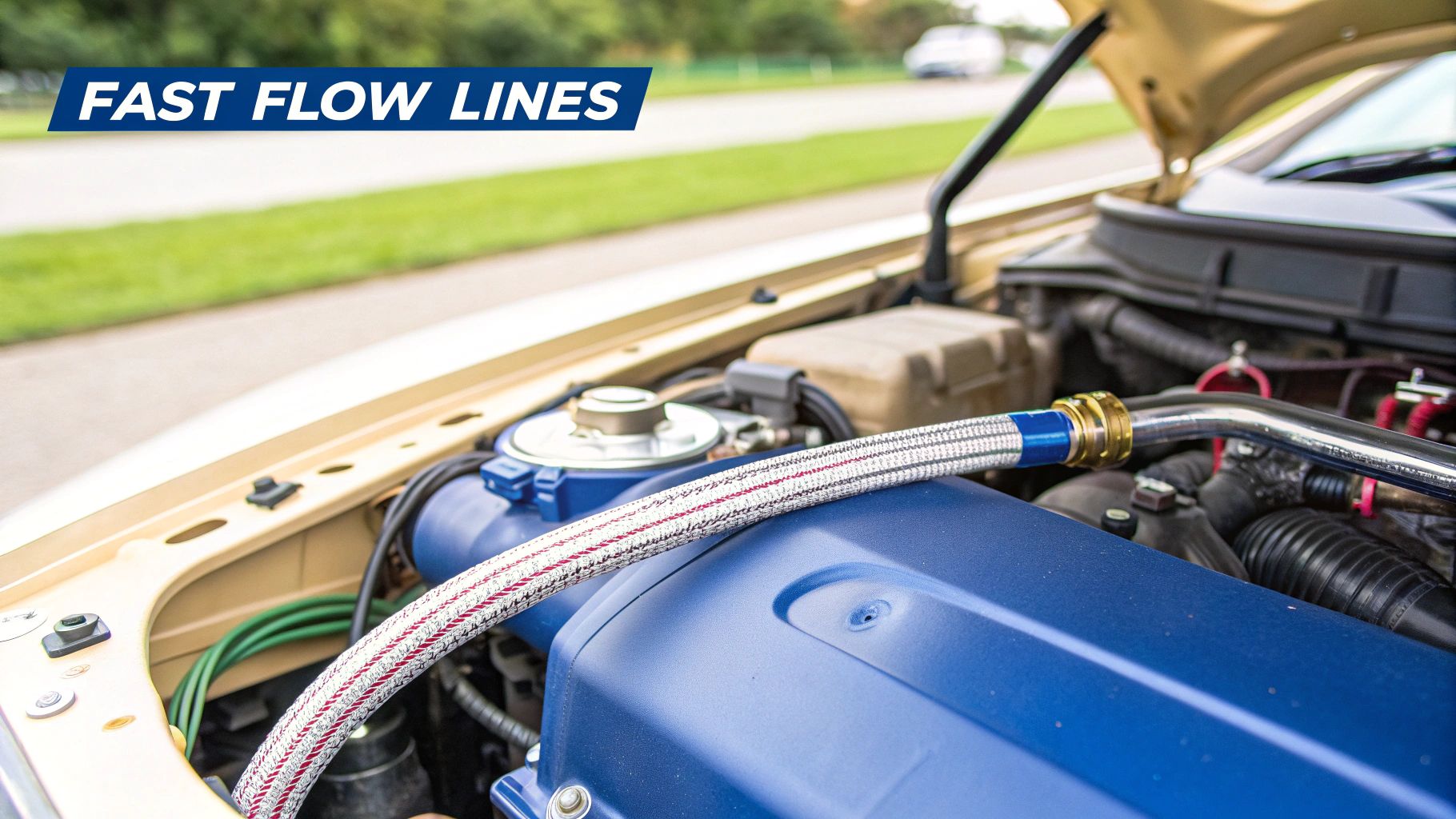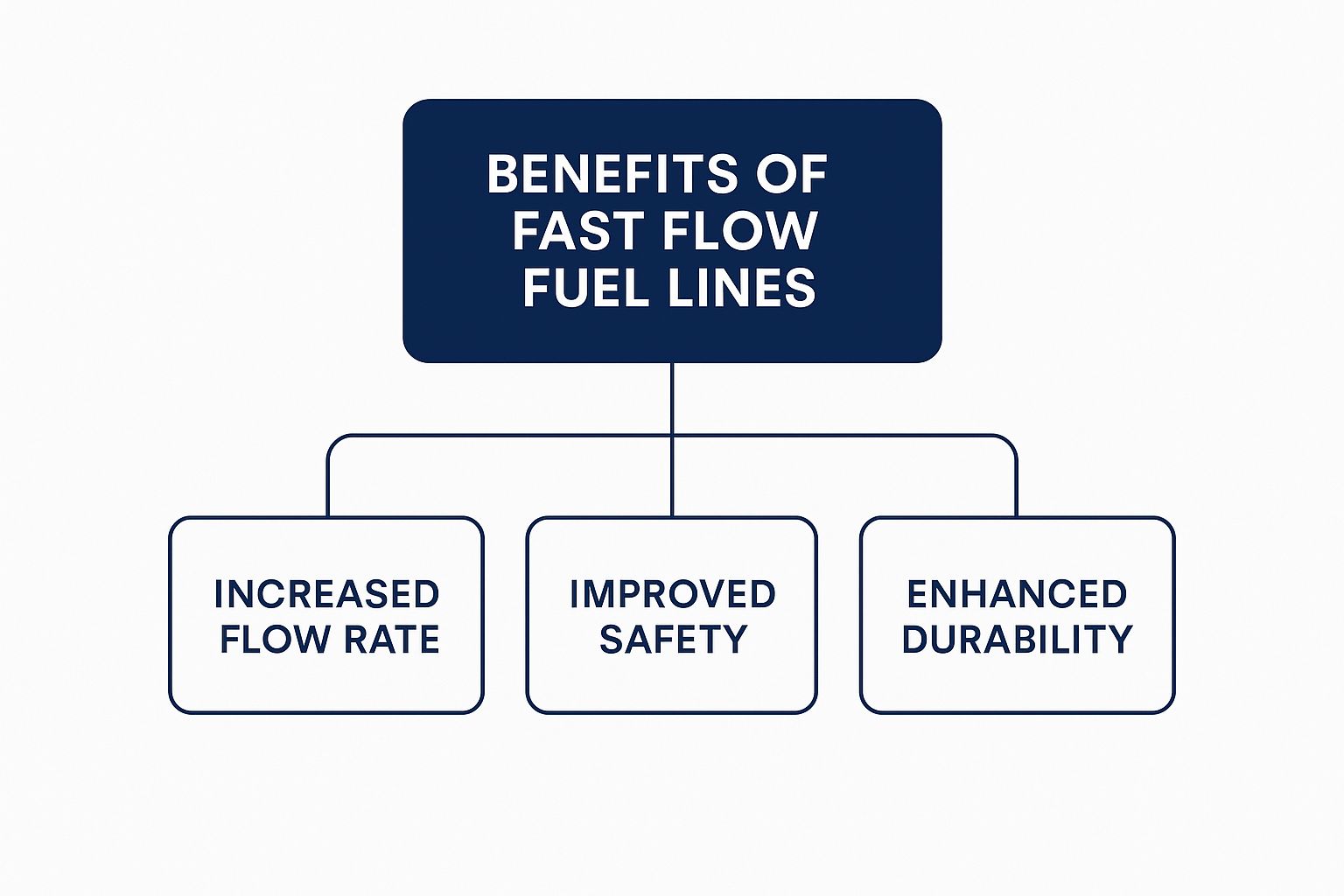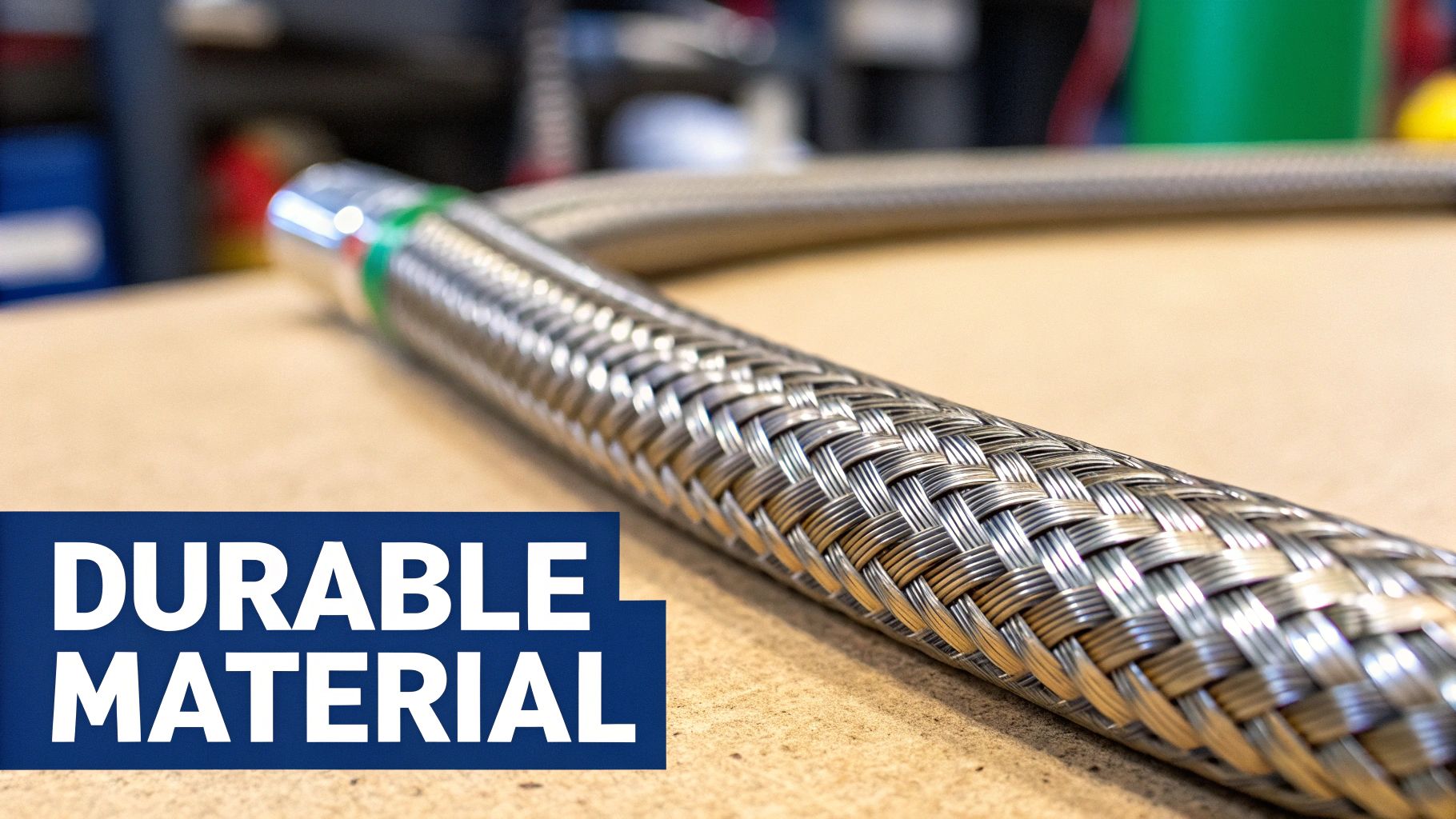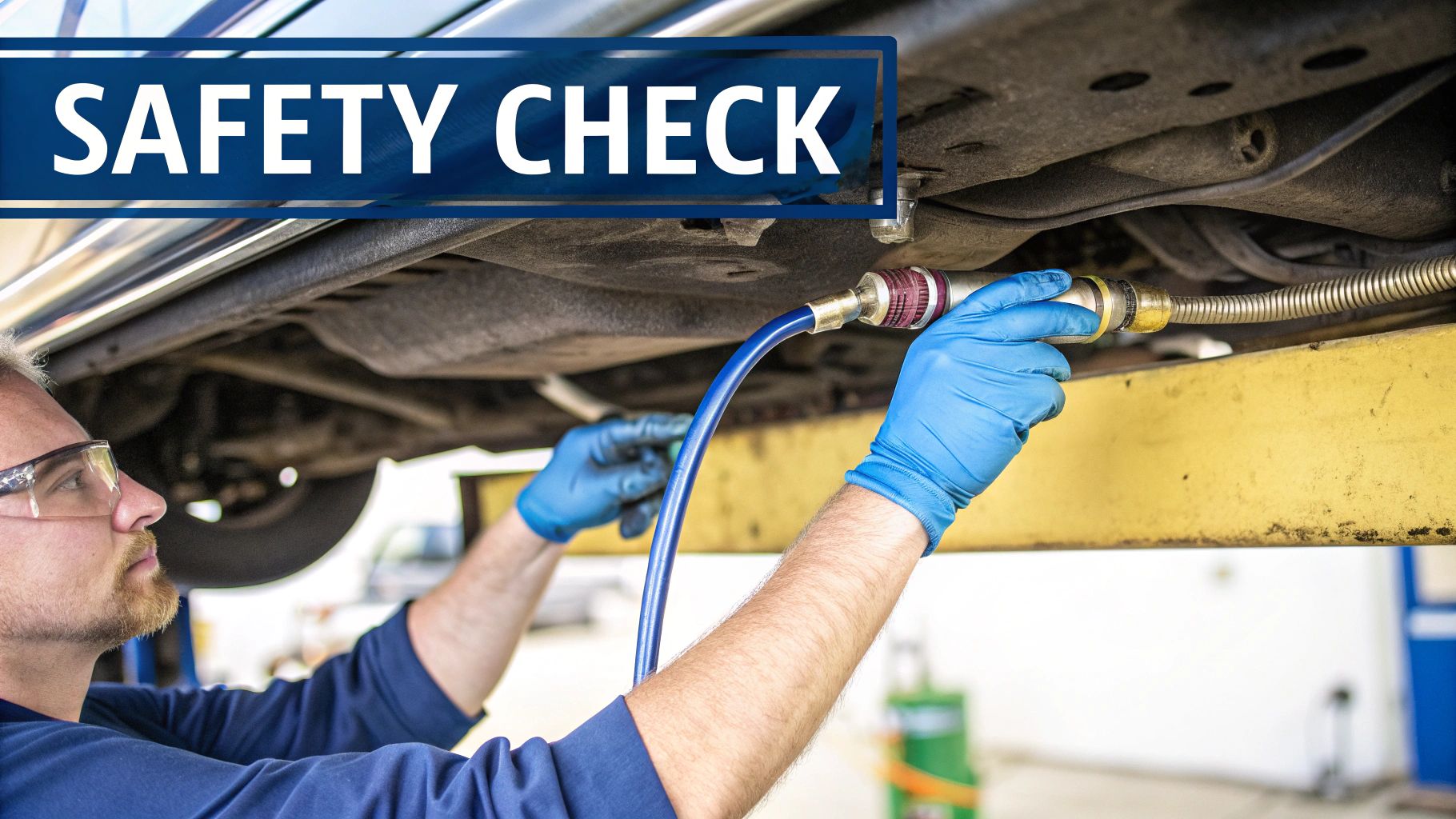If you've spent time and money modifying your engine for more power, the last thing you want is for your stock fuel system to hold you back. This is where fast flow fuel lines come in. Think of them as a critical upgrade, like widening a highway to handle more traffic—they prevent a fuel system bottleneck that can choke your engine's performance.
Without them, a high-performance engine can be starved of the fuel it desperately needs, failing to deliver the horsepower you've worked for and even risking serious damage.
Unlocking Your Engine's True Potential

Let's use a simple analogy: think of your engine's fuel system like the plumbing in your house. A standard, off-the-lot engine is like a small cottage. The factory-installed pipes are just fine for running the kitchen sink and a shower. They supply enough water—or in this case, fuel—for everyday needs.
But when you start adding serious modifications like a turbo, a supercharger, or aggressive cams, you're essentially turning that cottage into a high-rise apartment building. The demand for fuel suddenly goes through the roof. Those original, narrow "pipes" just can't keep up, and you've created a major bottleneck.
This is what's known as fuel starvation, a condition that can cause a whole host of performance issues and, even worse, engine damage.
The Problem With Stock Fuel Lines
When an engine can't get enough fuel, especially when you're on the throttle, it starts to run "lean." A lean air-fuel mixture means there's too much air and not enough gasoline in the combustion chamber, which is bad news for any engine.
A lean condition can cause several major problems:
- Serious Power Loss: The engine might bog down, hesitate, or feel sluggish right when you're expecting it to pull the hardest.
- Engine Knock (Detonation): Without enough fuel to properly control combustion, you can get violent, uncontrolled explosions inside the cylinders that can destroy pistons and other critical components.
- Dangerously High Temperatures: Running lean makes combustion temperatures skyrocket, putting immense stress on the entire engine.
Fast flow fuel lines are the direct solution. By swapping out those restrictive factory lines for larger-diameter, higher-capacity ones, you're upgrading the entire fuel delivery system to match your engine's new appetite for power.
It's no surprise that the demand for these upgrades is booming. The high-flow fuel lines market has grown into a massive industry, reaching a global size of USD 2.45 billion as more and more enthusiasts push for better performance. This just goes to show how essential these parts are in modern tuning. You can dig deeper into the high-flow fuel line market drivers to see the full picture.
Standard vs. Fast Flow Fuel Lines at a Glance
To make the distinction crystal clear, here’s a quick rundown of how these two types of fuel lines stack up against each other.
| Feature | Standard Fuel Line | Fast Flow Fuel Line |
|---|---|---|
| Primary Purpose | To meet the fuel demands of a stock engine. | To supply high volumes of fuel to modified engines. |
| Inner Diameter | Narrow, designed for efficiency, not high volume. | Wider, allowing for significantly greater fuel flow. |
| Performance | Adequate for daily driving; restrictive for power. | Essential for preventing fuel starvation under load. |
| Ideal Use Case | Unmodified, factory-spec vehicles. | Turbocharged, supercharged, or high-HP engines. |
Ultimately, choosing the right fuel line comes down to matching the hardware to your horsepower goals. For a stock daily driver, factory lines are fine. But for anything built to perform, fast flow lines are non-negotiable.
How to Choose the Right Fuel Line Size and Material
Picking the right fast flow fuel line isn't just about grabbing something off the shelf. Think of it like plumbing a house—a tiny pipe won't supply enough water for all the faucets, but a massive water main for a small cabin is just wasteful. The same logic applies directly to your engine's fuel supply.
You’ve got to match the line's size and material to your engine’s power and the type of fuel it drinks. Get this right, and you're building a reliable, high-performing fuel system. Get it wrong, and you might create a dangerous bottleneck that chokes your engine right when it needs fuel the most.
Demystifying Fuel Line Sizing
In the performance world, we don't really talk in standard inches. Instead, you'll hear the term AN sizing, which stands for Army-Navy. It’s a standard that refers to the outer diameter of the tubing in sixteenths of an inch. A -6AN (pronounced "dash six") line has an outer diameter of 6/16" (or 3/8"), while a bigger -10AN line measures 10/16" (or 5/8").
The whole point is to match the AN size to your horsepower goals. A line that’s too small will starve the engine of fuel, but going way too big is just extra cost and weight you don't need.
Here’s a good rule of thumb to get you started:
- -6AN (3/8"): This is usually plenty for naturally aspirated engines making up to around 500 horsepower.
- -8AN (1/2"): This is the sweet spot for a huge number of builds. It's a fantastic all-around choice for engines in the 500-800 horsepower range, whether they're naturally aspirated or have a turbo or supercharger.
- -10AN (5/8"): When you're making serious power, this is your go-to. It's built for engines pushing 800 horsepower or more, and it's practically a requirement if you're running high-volume fuels like E85.
The right size ensures your fuel pump isn't doing all that work for nothing. A high-flow pump is useless if the line itself is the restriction. That can cause a serious drop in fuel pressure right at wide-open throttle, which is a recipe for disaster.
Selecting the Best Fuel Line Material
Once you've got the size figured out, your next big decision is the material. This is crucial. Modern fuels, especially stuff like E85 with its high ethanol content, can be incredibly corrosive and will literally eat through the wrong kind of rubber hose. Choosing a compatible material isn't just about performance—it's about safety.
This image really drives home why an upgrade is worth it.

As you can see, it all starts with better flow, but that trickles down into making the whole system tougher and safer.
To help you decide, I’ve put together a quick table comparing the most common materials you'll find.
Fuel Line Material Compatibility and Use Cases
| Material Type | Compatible Fuels | Pros | Cons |
|---|---|---|---|
| Braided Stainless Steel | Gasoline, some diesel | Excellent abrasion resistance, classic look | Inner rubber core often incompatible with E85/methanol, can be rigid |
| Braided Nylon | Gasoline, some diesel | Lightweight, more flexible than steel, clean look | Check inner core compatibility for ethanol, less abrasion-resistant than steel |
| PTFE (Teflon) | All Fuels (Gasoline, E85, Methanol) | Gold standard for compatibility, no fuel smell (non-permeable), handles high pressure | Can be less flexible, requires specific PTFE fittings |
As the table shows, your fuel type is the biggest factor. For a basic gasoline setup, traditional braided lines are often fine. But if you’re planning on running E85 or other aggressive race fuels, you can see why PTFE is the top choice. Let's break it down a bit more:
- Braided Stainless Steel (Rubber Core): This is the old-school, classic choice. It’s tough as nails and looks great, offering fantastic protection against rubbing and heat. The catch? The inner rubber hose is often not rated for ethanol, which will cause it to swell, crack, and break down over time.
- Braided Nylon: A more modern option, braided nylon is much lighter and more flexible than stainless steel, which makes routing it through a tight engine bay a whole lot easier. It also has a clean, blacked-out look. Just like with steel lines, you must check that the inner core is compatible with your fuel.
- PTFE (Teflon): For any serious performance build, especially with modern fuels, this is the way to go. PTFE is a type of plastic that is completely inert to pretty much any chemical you can throw at it. It won’t break down with E85, methanol, or any other exotic fuel. A huge side benefit is that PTFE lines don't let fuel vapors seep through, which means you won't get that constant fuel smell in your garage.
Matching Your Fuel Lines to Modern Fuels like E85

Let's get one thing straight: the fuel you pump today isn't the same stuff your dad's old muscle car ran on. With ethanol-blended gasoline, especially E85, becoming a go-to for making big power, we've got a new set of rules to play by. These modern fuels are aggressive, and they can be downright corrosive to older fuel system parts.
Your fuel lines are on the front line of this chemical battle. Trying to run E85 through a standard rubber hose is like trying to hold acid in a paper cup—it’s not a matter of if it will fail, but when. The ethanol will chew through the rubber, causing it to swell, crack, and turn brittle in no time.
This isn't just some minor inconvenience. It’s a massive safety risk. A leaky fuel line in a hot engine bay is a recipe for a catastrophic fire. That's why fuel compatibility isn't just a suggestion; it’s a non-negotiable part of picking the right fast flow fuel lines.
Why PTFE Is the Gold Standard
If you're building a car to run on E85, methanol, or any other aggressive race fuel, there's really only one material to trust: PTFE (Polytetrafluoroethylene). You probably know it by its brand name, Teflon. PTFE is chemically inert, which is a fancy way of saying it just doesn't care about the nasty stuff in modern fuels.
Here’s why it’s the only real choice for a serious performance fuel system:
- Total Chemical Resistance: It won’t break down, get gummy, or swell up when swimming in high concentrations of ethanol or methanol.
- Zero Fuel Permeation: Ever notice that constant fuel smell in your garage? That’s because standard rubber hoses actually "sweat" microscopic fuel vapors. PTFE is completely non-permeable, so those fumes stay locked inside.
- High-Pressure Durability: These lines are built from the ground up to handle the crazy-high pressures of modern fuel injection systems without breaking a sweat.
Think of a PTFE-lined hose as an investment in peace of mind. It ensures your fuel system can deliver the flow your engine demands while standing up to the harshest fuels you can throw at it.
Do's and Don'ts for Fuel Compatibility
Getting your fuel system right is all about making smart choices from the get-go. A few simple rules can save you a world of headaches down the road.
Do's for a Safe Fuel System:
- DO use PTFE-lined hoses for any setup running E85, E98, or methanol. No exceptions.
- DO make sure you're using fittings designed specifically for PTFE hoses. Standard AN fittings won't seal properly and will eventually leak.
- DO get in the habit of inspecting your entire fuel system regularly. Look for any signs of wear, leaks, or damage.
Don'ts to Avoid Catastrophe:
- DON'T even think about using traditional rubber or nitrile-core braided lines with high-ethanol fuels.
- DON'T mix and match different types of hoses and fittings. Stick to one compatible system.
- DON'T grab any old hose clamp from the hardware store. For high-pressure EFI, you absolutely need fuel-injection-rated clamps.
This need for reliable, compatible components is industry-wide. In fact, the market for fuel line connectors is now valued at roughly $2.3 billion, a clear sign of how critical secure connections have become. You can read more about the growth of the fuel line connector market to see the trends for yourself.
And if you're in the marine world, understanding how different additives affect your system is just as important. For more on that, check out our guide on fuel additives for boats.
Building a Complete High-Flow Fuel System
Installing top-notch fast flow fuel lines is a great start, but it's really just one piece of the puzzle. When it comes to performance fuel systems, you're only as strong as your weakest link.
Think of it like trying to fill a swimming pool with a drinking straw. It doesn't matter how big the pool is if you can't get the water there fast enough. Upgrading your fuel lines without upgrading the parts around them creates the exact same problem. Your new, wider lines are ready to carry a ton of fuel, but they need the right components to feed them and handle the flow.
The Core Components of a Balanced System
A truly balanced system makes sure fuel gets from the tank to your engine without hitting any new restrictions. Once you've got the lines sorted, it's time to look at the other players on the team. This is how you build a setup that delivers the consistent volume and pressure your engine is thirsty for.
Here’s the essential supporting cast for your new fuel lines:
- High-Volume Fuel Pump: This is the heart of your entire system. A stock pump simply can't push enough fuel to fill bigger lines, which means you've just moved the bottleneck from the lines to the pump.
- High-Flow Fuel Filter: It’s easy to forget, but a restrictive filter will choke your fuel flow just as badly as a skinny fuel line. You need one designed for higher volumes.
- Adjustable Fuel Pressure Regulator: This is the brain of the operation. It manages fuel pressure to make sure your injectors get a steady, reliable supply whether you're idling at a stoplight or slamming the throttle.
- Larger Fuel Rails (if applicable): In high-horsepower builds, factory fuel rails can become a major restriction, essentially starving the injectors furthest from the fuel source.
When you address each of these parts, you create a system where everything works together in harmony. This stops one component from holding back the others, guaranteeing your engine gets all the fuel it needs to perform at its peak.
Putting It All Together
Building a balanced system also means thinking about the entire fuel circuit—not just the supply side. The market for automotive fuel return lines, valued at an impressive USD 4.76 billion, shows just how critical managing the whole loop is. As engines get more powerful, every part of the system has to keep up.
For specialized applications, you'll need the right gear for the job, like high-flow diesel refueling nozzles that can handle extreme flow rates.
Every application has its own unique demands, too. A system built for a race car is going to be very different from one designed for a boat. If you’re working on a marine project, check out our guide on how to build a complete boat fuel system.
Safe and Secure Fuel Line Installation Practices

When you're working with fuel, there's no room for "good enough." Precision and an absolute commitment to safety are the name of the game. You can have the best fast flow fuel lines and fittings on the market, but they're only as reliable as the installation. A sloppy job is a ticking time bomb, leading to dangerous leaks, frustrating performance issues, or even a catastrophic fire.
This is where the pros stand out. Every connection, every clamp, every inch of the line is handled with meticulous care. The goal isn't just to get the engine running—it's to build a fuel system that's bulletproof, high-performing, and completely trustworthy for years to come.
Planning Your Fuel Line Route
Before you cut a single piece of hose, you need a plan. The very first step is mapping out the path your fuel lines will take from the tank to the engine. Think of it like you're an electrician running a critical wire: you need the safest, most direct route that avoids every potential hazard.
Your biggest enemies are heat, sharp edges, and moving parts.
- Avoid Extreme Heat: Keep your lines as far away from exhaust manifolds, headers, and turbos as possible. Constant exposure to high temperatures will cook the line over time, making it brittle and just waiting to crack.
- Steer Clear of Sharp Edges: Never, ever run a fuel line over a sharp piece of metal or through an unprotected hole. Always use a rubber grommet. The constant vibration of the vehicle will turn that sharp edge into a saw, and it's not a matter of if it will leak, but when.
- Keep Away From Moving Parts: Double-check that your lines are nowhere near suspension components, steering linkages, or drive belts. Anything that moves, pivots, or spins can pinch, stretch, or rub right through a fuel line.
Proper routing is the absolute foundation of a safe fuel system. Spending an extra 30 minutes to find the perfect, safe path can prevent thousands of dollars in damage and, more importantly, keep you safe.
Securing and Clamping Your Lines
Once your route is mapped, you have to secure the lines properly. This is non-negotiable. A fuel line that's left loose to flop around or vibrate against the frame is a disaster waiting to happen. The right clamps are your best friends here.
Don't just grab any old clamp from the hardware store. Standard worm-gear clamps are notorious for cutting into the hose when overtightened, creating a serious weak spot. You need to use clamps specifically designed for fuel systems, like fuel-injection-rated clamps, which apply even, 360-degree pressure without biting into the line.
Best Practices for Securing Lines:
- Use P-Clamps: These rubber-lined metal clamps are the gold standard. They bolt directly to the chassis, holding the line firmly in place while the rubber insert absorbs vibration and prevents abrasion.
- Maintain Proper Spacing: Secure the line every 12 to 18 inches or so. This prevents it from sagging, kinking, or whipping around.
- Allow for Flex: In areas where there's movement—like the connection between the engine and the chassis—be sure to leave a little bit of slack. This service loop prevents the line from being stretched and stressed as the engine moves on its mounts.
These rules apply whether you're working on a race car or a fishing boat. For a closer look at how these practices are adapted for the water, you can learn more about marine fuel line installation and care.
After everything is tightened down, the final, most crucial step is the leak check. Pressurize the system and go over every single connection with a flashlight and a paper towel. Look for any hint of moisture or weeping fuel. Do this before you even think about starting the engine—your safety literally depends on it.
Got Questions About Fast Flow Fuel Lines? We've Got Answers.
Jumping into a performance fuel system upgrade is exciting, but it’s natural for questions to pop up along the way. Getting these details right is the difference between a bulletproof, high-horsepower setup and one that’s a constant source of frustration.
Let's tackle some of the most common questions we hear. Think of this as a quick-reference guide to help you build with confidence and avoid those late-night headaches.
Can I Use Fast Flow Lines on a Stock Engine?
This is a big one. The short answer? Yes, you can, but you probably won't feel any difference. A factory engine is designed to work perfectly with its stock fuel system—the two are precisely matched.
The real magic of fast flow fuel lines happens when you start modifying your engine. Once you add a turbo, a supercharger, or make other serious upgrades, your engine gets thirsty for more fuel than the stock parts can deliver. That's when these lines become essential. So, unless you're planning for future mods, it's an upgrade you can save for later.
What’s the Real Difference Between AN and Standard Fittings?
Understanding this is absolutely critical for building a leak-free performance fuel system. It all comes down to how they seal.
- AN (Army-Navy) Fittings are the go-to for a reason. They use a unique 37-degree flared surface to create a super-reliable, metal-to-metal seal. This design is the gold standard in racing and high-performance builds because it stands up to intense pressure and vibration without leaking.
- Standard Fittings typically use things like compression sleeves, pipe threads with goop on them, or simple rubber O-rings. They work just fine for your daily driver, but they can become a weak link under the demanding conditions of a modified engine.
For a system you can truly trust, stick with AN fittings that match your fuel lines.
A word of advice: When you upgrade, go all in. Using a complete AN-style setup from the fuel tank all the way to the engine ensures every connection is built to the same high standard. It’s the best way to eliminate potential weak points and build a truly reliable system.
How Do I Know if My Engine Is Starving for Fuel?
Fuel starvation is sneaky. It doesn't usually show up when you're cruising around town—it rears its ugly head right when you're demanding the most from your engine.
Here are the classic tell-tale signs to watch for:
- The engine sputters, hesitates, or just falls flat on its face when you accelerate hard.
- Your air/fuel ratio (AFR) gauge shows a lean condition (this is a dead giveaway).
- You feel a noticeable loss of power in the upper RPM range.
- In really bad cases, you might even get a backfire through the intake.
The best way to be sure is to monitor your fuel pressure. If you install a fuel pressure gauge and see the pressure drop like a rock under a heavy load, you've found your problem. Your fuel system just can't keep up.
Is a Return Line Really Necessary for My System?
That depends entirely on the kind of system you're building. Most serious performance setups use a return-style system, and for good reason. In this design, a regulator circulates any unused fuel back to the tank.
Why is this better? It keeps the fuel pressure at the fuel rail rock-solid, which is crucial for getting consistent performance from your injectors. While many modern cars have "returnless" systems, converting to a return-style setup is often the most reliable path forward when you're chasing big power. It guarantees your engine gets the fuel it needs, exactly when it needs it.
At CLiX Fueling Solutions, we know that a reliable fuel system is just as much about safety as it is about performance. Our innovative products are engineered to prevent dangerous spills and overfills, giving you peace of mind while protecting your boat and the environment. Learn more on our website.












